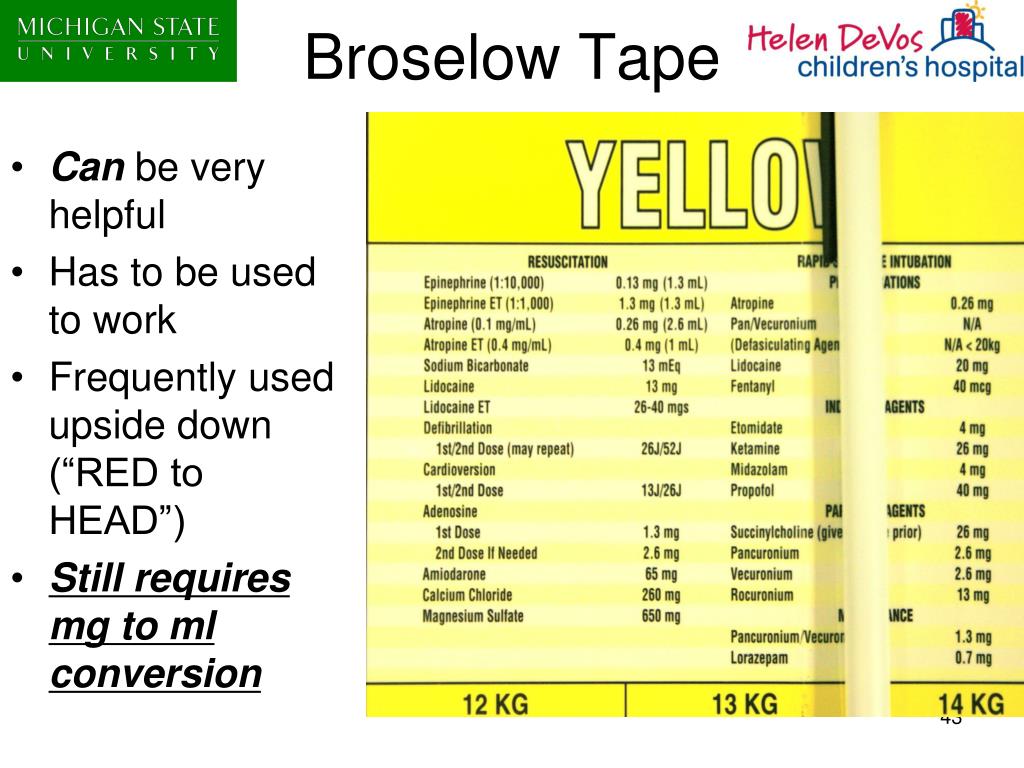

Conclusion: The Broselow Tape underestimated the weights of both overweight and obese patients, suggesting the need for adjustment of the length-based dosing zones for overweight and obese patients. Obese patients had a one-zone misclassification rate of 71% and a two-zone misclassification rate of 23%. Overweight patients had a one zone misclassification rate of 83%. Results showed that the misclassification rate of Broselow Tape increases with BMI percentile values. Results: Percent of true classification and misclassification of body weight zones was calculated for each BMI percentile category. Sold by Alex-Shops and ships from Amazon Fulfillment.
Broselow tape how to#
Ships from and sold by The First Aid Zone. The purpose of this study packet is to introduce the learner to the Broselow tape and describe how to use the Broselow Tape correctly and effectively. Dose By Growth Updated (Reviewed in 2022) - EMS Standard Pediatric Emergency Length-Based Tape Broselow Compatible Color Zones Designed for Paramedics, Nurses & EMS Providers 1 Count (Pack of 1) 58 2499 (24.
Broselow tape free#
SAS 9.4 was used for all statistical analyses with an alpha level of 0.05 to assess statistical significance. This item: Broselow - Broselow Pediatric Emergency Tape - 44.95 44. Broselow - Broselow Pediatric Emergency Tape - 32 4495 FREE delivery Sep 14 - 18 Only 10 left in stock - order soon. Heights and weights were recorded and compared to predicted Broselow Tape weight. The Broselow Pediatric Emergency Tape is one piece of the Broselow-Luten Color Coding system (B-LPS) that helps nurses, paramedics and emergency medical technicians to administer medicine and use various sizes of medical equipment on children according to their approximate weight and height. Subjects were placed into groups according to the CDC guidelines of BMI percentile categories: underweight, normal, overweight, obese. Methods: A retrospective chart review was performed using the electronic medical records at the Children’s Hospital of Georgia in Augusta University, between May 2015- March 2018. It was hypothesized that the predicted weight needed adjustment by at least color zone for obese and overweight patients in order for them to receive adequate medication during emergency. This study aims to determine the accuracy of the Broselow Tape among pediatric patients with a body mass index (BMI) greater than the 85th percentile. The rise of childhood obesity in the United States, with a prevalence of 18.5% in 2016, has brought up recent concerns for underestimation of weight using the Broselow Tape. The next best alternative is the Broselow tape in children aged 5 years or younger and the Mercy method in children aged older than 5 years.Introduction: The Broselow Tape is a color-coded tape that uses height to predict weight-based dosage of medications and equipment sizes in order to safely treat pediatric patients in medical emergencies. Parental estimation was the most accurate method in every age group. The Broselow tape had the highest score for practicality of use. The Mercy method was the second most accurate tool in the 6-to-10-year and 11-to-12-year age groups (ME = -2.47 and -2.77 accuracy = 54.6% and 67.9%, respectively). The Broselow tape was the second most accurate tool in ages younger than 1 year and 1-to-5-year age groups (ME = 0.23 and 0.50 kg accuracy = 55.3% and 54.1%, respectively). Parental estimation was the most accurate tool in all age groups, with the lowest overall mean error (ME) of -0.83 kg and the highest accuracy of 88.7%. A reference at each color bar on the tape informs you of equipment sizes to perform emergency resuscitation on the child. A strong correlation between estimated weight and actual weight in all methods was demonstrated. Practicality was evaluated by time usage and data derived from user questionnaires.įour hundred thirty participants with mean age of 6.7 years and mean weight of 26 kg were enrolled. To determine the accuracy of the Broselow tape on estimating body weights of selected Saudi children. Validity was assessed by mean bias (estimated weight minus actual weight) and accuracy (10% error).

Correlations between estimated and actual weights were tested. This study aimed to evaluate the validity, reliability, and practicality of these tools.Ī prospective observational study was conducted in healthy Thai children aged 6 months to 12 years. Although several weight estimation methods exist, the most precise method has not been conclusively determined.

Obtaining accurate pediatric weight is necessary during emergency resuscitation.


 0 kommentar(er)
0 kommentar(er)
